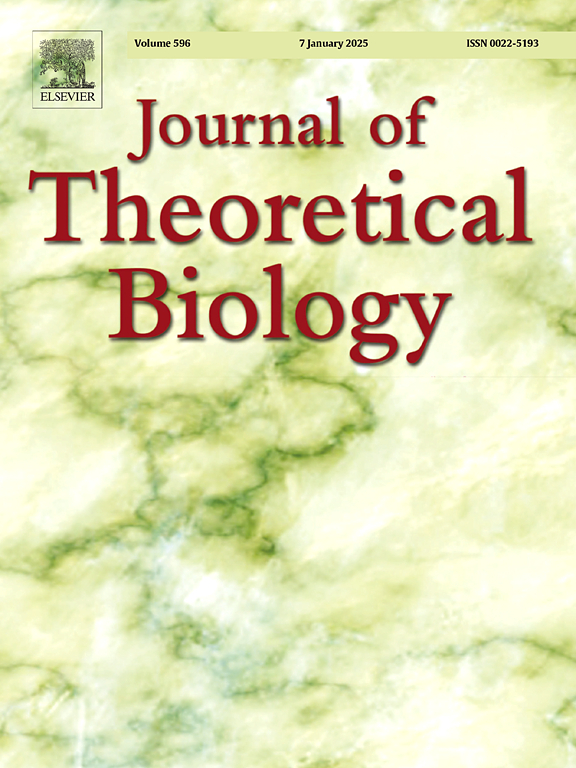感染是不一样的:个体易感性和传染性之间的共变对流行病动力学的影响。
IF 2
4区 数学
Q2 BIOLOGY
引用次数: 0
摘要
对感染的易感性和感染的传播性的个体水平差异可影响流行病暴发时的种群水平动态。先前的工作已将个体易感性或传播性的独立变异纳入流行病区室模型。在这里,我们开发并评估了一个数学框架,其中包括易感性和传导性的共变。我们表明,易感性和传播率的不相关变化导致有效的传播率分布具有恒定的变异系数,从而使流行动态与单独的易感性变化相匹配,为不同相关结构之间的比较提供了基线。增加易感性和传播性之间的相关性可增加暴发的速度和强度,并表明可能由接触率变化强烈构成的暴发。相反,易感性和传播性之间的负相关性导致总体上较弱的疫情——需要注意的是,有效传播的强度随着时间的推移而增加。在任何一种情况下,相关性都可以改变传播性分布,从而随着易感人群的减少而改变流行病的传播速度。总的来说,这项工作证明了易感性和传播的共同变异(通常未被解释)如何影响疫情的过程和最终的疫情规模。本文章由计算机程序翻译,如有差异,请以英文原文为准。
Infections are not alike: The effects of covariation between individual susceptibility and transmissibility on epidemic dynamics
Individual-level variation in susceptibility to infection and transmissibility of infection can affect population-level dynamics in epidemic outbreaks. Prior work has incorporated independent variation in susceptibility or transmissibility of individuals into epidemic compartmental models. Here, we develop and assess a mathematical framework that includes covariation in susceptibility and transmissibility. We show that uncorrelated variation in susceptibility and transmissibility leads to an effective transmissibility distribution that has a constant coefficient of variation such that the epidemic dynamics match those with variation in susceptibility alone, providing a baseline for comparison across different correlation structures. Increasing the correlation between susceptibility and transmissibility increases both the speed and strength of the outbreak – and is indicative of outbreaks which might be strongly structured by contact rate variation. In contrast, negative correlations between susceptibility and transmissibility lead to overall weaker outbreaks – with the caveat that the strength of effective transmission increases over time. In either case, correlations can shift the transmissibility distribution, thereby modifying the speed of the epidemic as the susceptible population is depleted. Overall, this work demonstrates how (often unaccounted) covariation in susceptibility and transmission can shape the course of outbreaks and final outbreak sizes.
求助全文
通过发布文献求助,成功后即可免费获取论文全文。
去求助
来源期刊
CiteScore
4.20
自引率
5.00%
发文量
218
审稿时长
51 days
期刊介绍:
The Journal of Theoretical Biology is the leading forum for theoretical perspectives that give insight into biological processes. It covers a very wide range of topics and is of interest to biologists in many areas of research, including:
• Brain and Neuroscience
• Cancer Growth and Treatment
• Cell Biology
• Developmental Biology
• Ecology
• Evolution
• Immunology,
• Infectious and non-infectious Diseases,
• Mathematical, Computational, Biophysical and Statistical Modeling
• Microbiology, Molecular Biology, and Biochemistry
• Networks and Complex Systems
• Physiology
• Pharmacodynamics
• Animal Behavior and Game Theory
Acceptable papers are those that bear significant importance on the biology per se being presented, and not on the mathematical analysis. Papers that include some data or experimental material bearing on theory will be considered, including those that contain comparative study, statistical data analysis, mathematical proof, computer simulations, experiments, field observations, or even philosophical arguments, which are all methods to support or reject theoretical ideas. However, there should be a concerted effort to make papers intelligible to biologists in the chosen field.

 求助内容:
求助内容: 应助结果提醒方式:
应助结果提醒方式:


